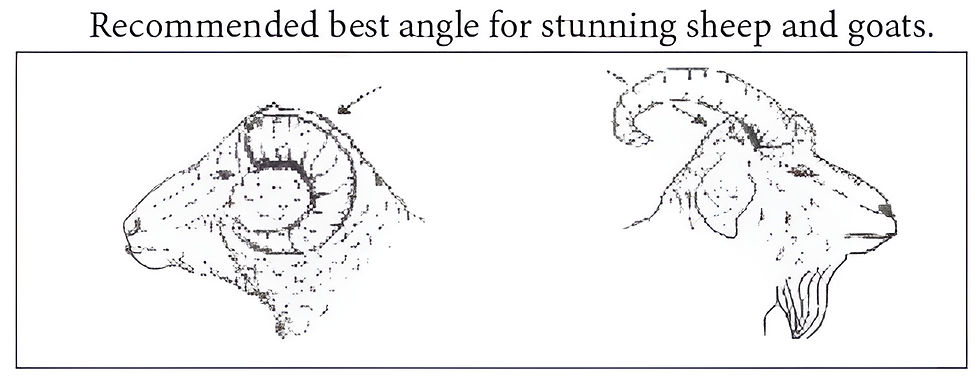Pick the Perfect Powerload — Your Quick‑Glance Charts for .22 & .25 Cartridges
- Jarvis Canada

- Sep 18
- 3 min read
Updated: Sep 25
Not all blanks are built the same! Matching cartridge strength to species and size is just as important as choosing the right stunner. Too light, and you risk a mis‑stun; too heavy, and you stress the equipment and the carcass. That’s why we’ve laid out two easy reference charts—one for .22‑calibre loads and one for .25‑calibre loads—showing exactly which grain weight and colour code Jarvis recommends for everything from rabbits and piglets to mature bulls and bison.
Use these guides to double‑check your daily setup, train new staff, or troubleshoot a tricky stun. And remember the golden rule plastered across every Jarvis manual: never exceed the load prescribed for your stunner model. Always follow your operator’s guide, keep spare colours on hand, and you’ll hit that one‑shot, humane stun every time.


Best Placement and Angles for Captive-Bolt Stunning

Cattle
Frontal Position (Preferred)
Placement: on the midline of the forehead, at the intersection of two imaginary lines drawn from the inside corner of each eye to the base of the opposite horn (or to the top of the opposite ear in hornless breeds). This is about 4–7 cm above the eye line.
Angle: hold the stunner perpendicular (90°) to the skull, muzzle flat against the forehead. The bolt should travel straight back through the cerebrum into the midbrain/brainstem.
Reasoning: this alignment ensures maximum disruption of the brainstem, which governs consciousness and vital functions.
Key Notes:
Do not aim between the eyes (too low) — risk of missing the brainstem.
Ensure the muzzle is flat and firmly pressed against the skull.
For mature bulls, use a longer bolt (≈15 cm) and higher-caliber cartridge to penetrate thicker skulls.

Sheep
Hornless (Polled) Sheep
Placement: on the top of the head, midline, at the highest point of the skull.
Angle: hold the stunner straight down (90° to the skull), aiming toward the throat/jaw angle. This ensures the bolt travels vertically into the center of the brain and down toward the brainstem.
Horned Sheep
Placement: on the midline just behind the horn ridge (poll position).
Angle: direct the bolt forward and downward toward the base of the tongue/back of the throat.
Reasoning: this bypasses the thick horn base bone, delivering energy to the brainstem region.
Key Notes:
Avoid frontal (between-the-eyes) shots, especially in rams—the thick forehead bone can deflect the bolt.
Always hold the stunner flush and square to the skull surface for full energy transfer.
Goats
All Goats (Treat as Horned)
Placement: on the midline just behind the bony horn mass (poll).
Angle: aim downward and forward toward the base of the tongue/back of the throat.
Reasoning: goats have an especially thick frontal bone; a frontal shot may fail to penetrate or concuss adequately. The poll position avoids the densest part of the skull and directs the bolt into the brain and brainstem.
Key Notes:
Never attempt a frontal forehead shot in adult goats.
Apply the stunner firmly perpendicular to the poll surface.

Pigs
Frontal Position (Preferred)
Placement: on the midline of the forehead, about 2 cm (20 mm) above eye level (or at the point where lines drawn from each ear to the opposite eye intersect). For mature boars/sows with a “dish” forehead, the ideal point may be slightly higher.
Angle: hold the stunner flush with the skull and angle the bolt slightly backward (toward the tail) — i.e., a rearward/straight-back trajectory through the skull toward the brainstem. Do not aim straight down between the eyes (too low) or straight up into the sinuses.
Reasoning: pigs have deep-set brains and extensive frontal sinuses; a slightly backward trajectory helps the bolt pass through the sinuses and reach the cranial vault and brainstem rather than lodging in sinus cavities.
Join Our Newsletter and Follow Us on Facebook
Stay connected with Jarvis Canada! Subscribe to our bi-weekly newsletter to keep up-to-date with exclusive sales, special promotions, and insightful blogs on industry trends and Jarvis innovations. Also, be sure to follow us on Facebook for frequent updates on exciting deals, promotions, new blogs, and opportunities to win fantastic free prizes!
About Jarvis Canada
Jarvis Canada Ltd
4650 112th Ave. S.E.
Calgary, Alberta, T2C 2K2
Phone: (403) 236-5350
Email: info@jarviscanada.com
Notice: All trademarks and brand names belong to their respective owners. Use of these names does not imply any connection or endorsement.
This content and other digital marketing for Jarvis Canada is Dream Powered.





Comments